The Lowdown
The endless variety within a confined structure is definitely something that appeals to me, and Inscryption handles it masterfully. I am going to give this game a 4.5/5, but it’s very likely that some of you will rate this higher. And that’s totally fine! The game’s simplicity belies its complexity and is another amazing addition to the landscape not created by a big studio. I applaud what they’ve done.
Overall
Pros
- Exceptional yet easy-to-understand card game mechanics, primarily in Act 1 and Post Game
- A+ atmosphere and storytelling
- Endgame that allows you to keep playing the best part…with a twist
Cons
- I didn’t care for Act II and III as much — they weren’t bad — Just a shadow of what Act I and Post Game are
Hold onto your toilet seats, ladies, germs, and nonbinary friends; we’ve got a card battler coming your way! But is that really all it is? More than just a card game, Inscryption is divided into three distinct acts that will leave you wondering what on earth is happening. It’s an ambitious undertaking, but you, the reader, must be careful before proceeding through this article because there will undoubtedly be things that you may wish to experience for yourself rather than read about. I’ll give you fair warning now and before each section so you can skip ahead if you’d prefer.
Anyway, I beat Inscryption‘s main game in about 11 hours; here are my thoughts.

So, I’ve reconfigured my methodology slightly when it comes to reviewing a game.
Prior to publishing a review, I used to not read any commentary or reviews from other publications just so I could go in with a clean slate on my own experiences. Recently, however, I’ve been looking at Steam reviews so I can see what my fellow gamers think about the stuff I’m planning to write a gospel on.
The resounding message for Inscryption goes something like, “DO NOT read anything about this game, go in blind.”
While I certainly understand that some people may want to go on the roller coaster without warning, in this case, I think it’s more important that people know about what is going on so that they can make informed decisions with their money.
Inscryption‘s marketing and images largely available mostly focus on the first Act, so I’d rather you get a little bit more information than you need as opposed to buying this purely based on what you saw on the store page and realizing that you think the rest sucks.
We’ve gotta make good decisions in this economy after all, but if you skip to the end, I don’t blame you. On the plus side, it’s one of the shortest reviews of mine you’ll ever read.
Without further ado, let’s start with:
Act 1: AKA My Favorite Part of Inscryption
From a first-person perspective, your character wakes up in an eerie log cabin. Some creepy hermit sits across from you and teaches you how to play a game known as Inscryption. The card game functions very similar to Yu-Gi-Oh, where your creatures battle against your opponents, and in order to summon stronger creatures, you must sacrifice weaker ones.
Each encounter ends when you deal enough damage to tip a set of scales all the way down on your opponent’s side, like proverbial judgment in the Egyptian underworld.
As you finish each encounter, you progress along a map that is marked with icons denoting what will happen when you reach your various destinations. If you’ve read my review of Curse of the Dead Gods, Inscryption is very similar in this manner.
Some nodes give you extra cards, some allow you to buff up your pre-existing animals, and some do some truly weird shit like allowing you to fuse two of the same beast into one.

It’s ALLIVVEEEEE!
All cards you are given are completely randomized, by the way, meaning that this is another version of a rogue-lite, where you do your best to cobble a successful run together based on what particular resources are given to you.
If you notice the Bullfrog above, the icons are explained as follows:
The left number represents the attack damage the creature will inflict each round. The right number represents the health that the creature has. The middle bottom symbol represents special abilities, and the top right blood marker indicates how many creatures need to be sacrificed in order to summon it.
At the start of every turn, you can draw a single card from one of two piles; one holds the creatures you’ve been collecting, and the other is squirrels. Squirrels provide only one health of stopping power and zero attack, but they are free, implying that they are either cannon fodder or sacrificial lambs, so to speak.
It is important to note that the enemy never has to sacrifice anything; they will play creatures in waves instead. The cards they play will start in the very top row for a singular turn before progressing down into the next, allowing them to attack you. This means that while you attack first and get a chance to deal some damage off the jump, your creatures are then vulnerable to take a hit from whatever is on deck.
It’s up to you as the player to strategize based on what’s coming down the pipeline.
In an added twist, you can get up from the table between encounters, and you quickly realize that the room has a series of puzzles that you can solve to upgrade your equipment and card selection.
For example, a painting depicts a specific layout with specific cards; should you match that during your run, you can receive an item. You can gain an extra life, a clover to reroll card choices, and/or a key to unlock another card option.
Once unlocked, these extra boons are available in future runs.
On the subject of your “life,” a set of candles to your right represents this; once they’re all snuffed out, the weird forest man snaps your picture and kills you.
Once dead, you can design a “death card” that combines elements from your previous deck. For example, you can take the cost it would take to play it from one creature, the attack damage and health points of another, and any residual abilities from a third to combine them into this new (and often very powerful) card.
If you’re lucky, you’ll get a good combination; if you’re luckier still, you may get a chance to find it on the battle board on your next run.
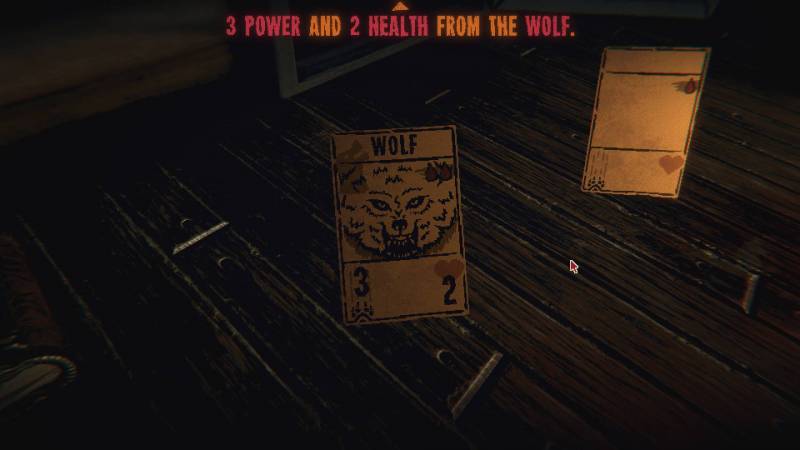
If you have a card that is free to play, definitely use that for your death card; action economy is underrated.
Upon returning to the table as the next “willing participant,” you start with a deck of pre-assorted creatures and try again.
As if all this isn’t weird enough, it becomes more apparent as time goes on that you are not the only individual trapped within Abe Lincoln’s house. A card resembling a stoat that has a TV for a head speaks to you and provides you hints as to where you may find other goodies scattered around the cabin.
More on that later, but not all is what it seems at this stage.
Each section of the “map” is headed by a specific boss. There’s the Prospector, the Angler, and (spoiler) the trapper/trader. They each have a specific mechanic as to how they play and multiple lives, meaning you need to tip their scales multiple times to move past them.
What’s more, they snuff out all your candles except for one, so you better make your singular chance count. I thought these three were pretty fun in terms of design, and their unique mechanics added an extra challenge that may take you a few attempts to wrap your head around.
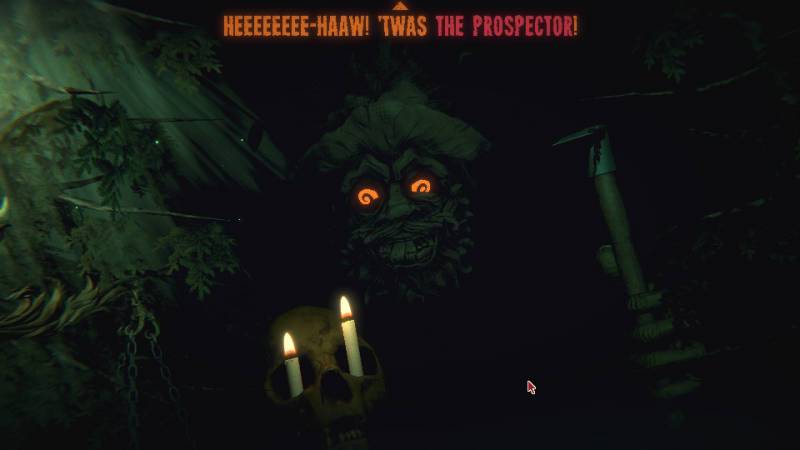
A note on Inscryption‘s design: it’s really quite eerie that the shadowy man playing against you dons the masks of these minibosses and acts out their actions to you. It’s really immersive; I truly loved it.
I’ll only divulge details on the first one, the Prospector. At the beginning of the encounter, he drops his pack mule onto the board, and once defeated, you will get whatever cards are hidden under the mule.
This is quite handy because after you snuff out one of his two candles, he uses his Prospector’s pick to wipe out your entire board and replace anything there with a useless gold nugget that you cannot sacrifice.
Plan accordingly…
After defeating them, you move forward to the next region and work your way up again. Upon defeating all three, you arrive at a suspiciously familiar cabin, and within, you find an overgrown tree man named Leshy. He is your tormentor, the game maker, and, for so many of your past selves, your executioner.
This is a heavy fight, as Leshy has a myriad of powerful creatures at his disposal. He also has THREE lives as opposed to two. His first wave is standard powerful creature waves, but in the second, he will start using the very death cards you created as his minions. As you can imagine, this can get out of hand really quickly.
This isn’t helped by the fact that he can, every two turns, use the ability of a previous miniboss to mess with your strategy.
Once you’ve managed to beat him twice, he decides you’re a true opponent and snaps a picture of the moon. Putting this on the board, you are now tasked with defeating the moon itself, and as you can imagine, it’s an absolute tank.
Pray that you’ve brought enough heat to defeat it. Should you prevail, you will be able to take his picture instead, provided you solved enough challenges in his cabin to find a roll of film and break the cycle you have found yourself trapped in.
The entire atmosphere is downright creepy, and you can tell how much attention the development team poured into the experience.
I’m not the squeamish type, but interacting with the forest god sitting across the table made the hair on my neck stand up once or twice. Every time he speaks to you in his contrite and dismissive way, a sound plays out like an oak groaning, but it’s just so ominous that it feels like you’re going to swallow it up.

This is an incredible part of the Inscryption progression, and I’m glad the post-game allows you to replay it. I will touch on that at the end of the article. There is so much more I want to tell you, but this is truly a section that is best left for you to discover on your own.
Also, to reiterate, this is the only section of Inscryption I’ve seen in general marketing, so if you’d like to stop here and discover the next few acts for yourself, please feel free.
Spoilers Will Begin Now
Act 2: It’s Earthbound…but Weird (SPOILERS)
So you’ve navigated your way out of the Ouroboros escape room and have beat the old hermit, but that’s not the end of your journey.
You quickly discover in this world, the reason this cabin even existed is that this variation of Inscryption puts Leshy in the role of a god. He has reworked the basic mechanics and layout in his image and his personality, so defeating him and taking his picture inevitably releases his control, and you are thrown back into what the game “should have been.”
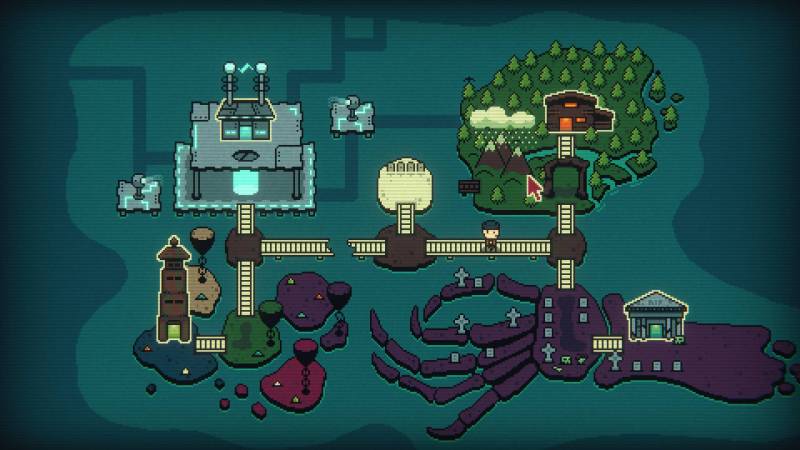
Pretty sus
Not much is fundamentally different here; your character is tasked with defeating four separate bosses who each control their own realms and abilities.
The lore behind this is that in the very beginning, there was nothing (stop me if you’ve heard this one before), but then four entities were created who all could warp reality in their own ways to create magic cards and make sense of the primordial ooze.
You will notice some familiar faces.
You obviously will recognize a small cabin fully equipped with the Prospector, Angler, Trapper/Trader characters, and, of course, Leshy himself. But those talking cards who helped you from Act 1 are now free to rule their realms in equal power.
The stoat is a robot named P03, the bug is a necromancer named Grimora, and the stunted wolf card is a “Cousin It” look-alike named Magnificus.
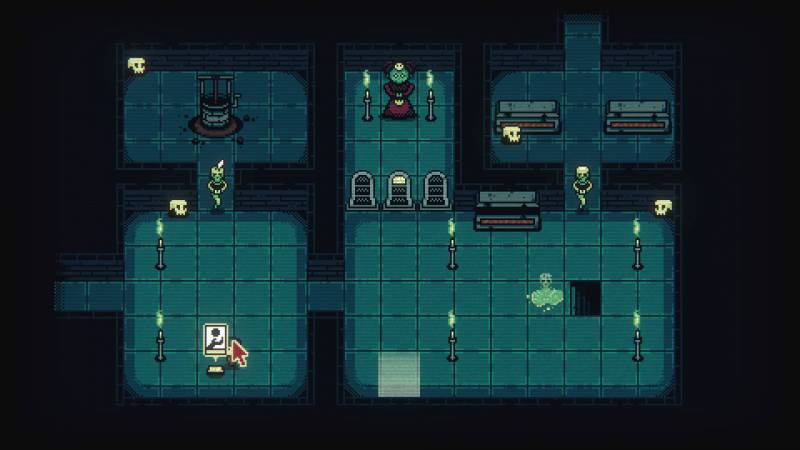
Each of them was given the ability to bind aspects of the world around them into cards through various means. While Leshy has his magical camera, P03 uses a factory to create robots, and Magnificus uses a magic paintbrush.
As you’d imagine, they each specialize in a different kind of creature, with Leshy having the usual repertoire of beasts while Grimora uses zombies. You have no restrictions on building your decks, so they can be combined as you see fit.
Very much like the first Act, there is a trove of secrets to discover while wandering around the map, but that will not be spoiled in this review. This is an Op-Ed, not a cheat sheet, after all.
This stage of the game is more straightforward in that you go around and defeat various opponents and, through defeating them, get card packs to expand your deck. Considering Leshy has lost sole control of the world, your cards are more varied and can be utilized in your deck in different ways. I’d start with Grimora’s deck if I were you; it’s easiest to wrap your head around.
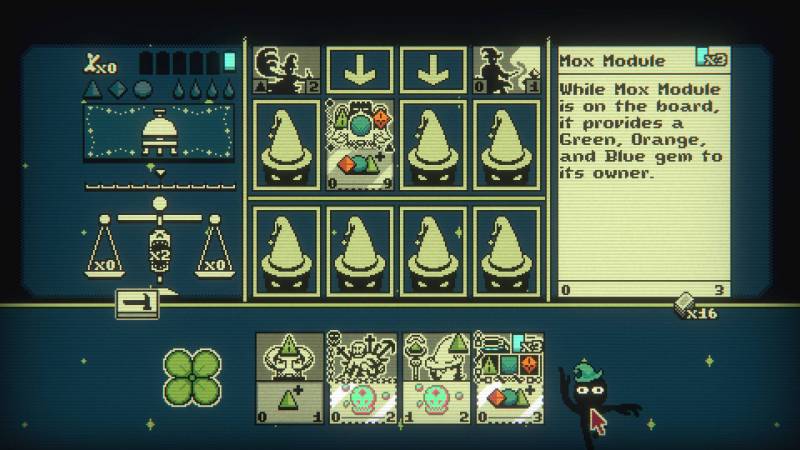
That’s really all I’ve got to say about Act 2. It didn’t resonate with me as much as the first section, clearly. Maybe it was the style (which I’m not a fan of), or perhaps it was the departure of the creepy vibe, but I found myself scrambling to get through it.
That’s not to say it’s bad, but it doesn’t hold a candle to the first. From a narrative standpoint, I will acknowledge that it is necessary to engage with the various characters within this world and discover the background as to why this game even exists.
Upon defeating all four of the bosses, you are given a choice as to who you would like to assume the place of and theoretically win the game. However, like everything in Inscryption, nothing is ever simple.
Act 3: Your Overlord Is a Toaster (Spoilers)
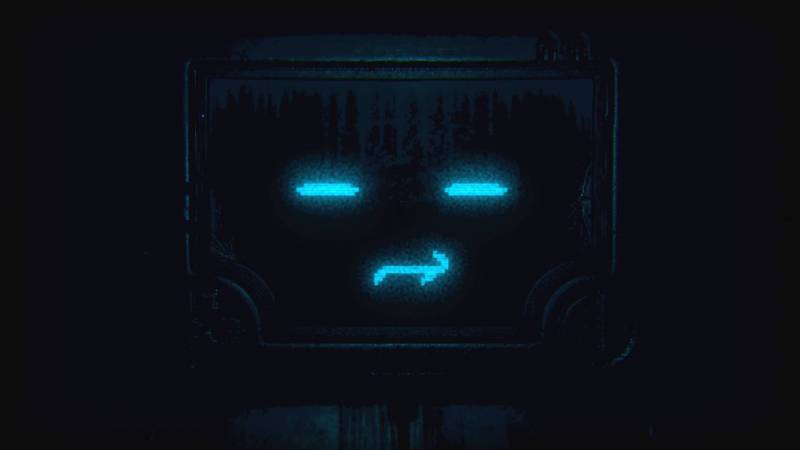
Surprise! Your pants got pulled down, and you’re hanging out at your graduation ceremony! P03, the friendly stoat from Act 1 and miniboss in Act 2 has been a little tricksy.
At the moment of your ascension, after defeating all four of the demigods in Act 2, P03 nabs control over the entire Inscryption code and reworks the world into his ideal game. You, the player, wake up chained to his card table, and he invites you to play “the best” version of Inscryption, thanks to his alterations.
What follows is a combination of the previous two Acts set in P03’s style. You wander around a map that combines the WASD navigation of Map 2 of Inscryption, and your encounters resemble the battles with Leshy from Act 1, albeit with robots instead of beasts.
All the while, it’s ironic that P03 constantly shits on the other characters and supplicates that his version is far superior, whereas, in my opinion, it seemed more like a reskin. I don’t know if the developers were making a point here, but it was still a funny observation nonetheless.
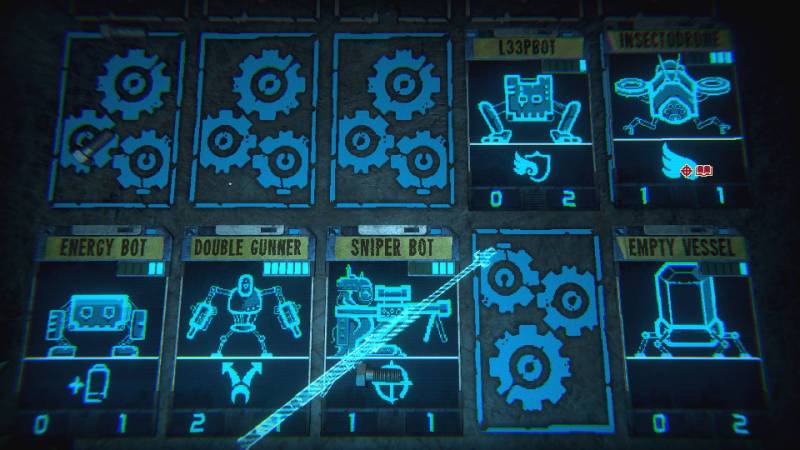
The key difference is that now, instead of sacrificing creatures, you have to build up “energy” to play your more powerful cards.
I will say that the four bosses (Uberbots) you must fight in this version are quite well thought out and have additional unique mechanics that make them a challenge to deal with. Finally, I’m getting some of that Act 1 nostalgia.
An example is the boss, who is clearly designed to represent Leshy. Equipped with a camera function, you, the player, can take a snapshot of the field and, upon activating the ability, can revert the game mat to that orientation of cards.
For example, taking a picture of a blank board allows you to commit a full reset, potentially giving you the advantage.
While this is pretty straightforward, another Uberbot called “The Archivest” does something actually genius.
The boss will actually scan your computer and have you pick files from your actual hard drive to use in the game. You will be instructed to pick the biggest or oldest file available, and it will create a card for you to play with stats based on how well you adhered to the criteria.
It can be unnerving but don’t worry, this game isn’t malware, it won’t actually mess with your “secret folder of homework” that’s totally not adult images.

This one’s fun, too; it allows you to add rules to the game
This is where the game went back to being fun for me, as despite the lack of a creepy forest dungeon aesthetic, tipping the scales the way I knew how and exploring the cabin for secrets was a great way to bring it back to the Inscryption I had come to expect.
After beating all Uberbots, you come to find out that P03 has set this all up to disseminate the game online. Each Uberbot has compiled all the components necessary to not only complete the game of Inscryption but also make an attractive Steam page to infiltrate Cheeto eaters’ hardware all over the globe.
Beating the Uberbots has allowed you to do what he couldn’t, like taking pictures of the game to use on the store or connecting P03 to the internet so he can disseminate the code.
P03 prepares to spread its influence to the world…only to have the other entities behead him.
They regain power, and Grimora proceeds to delete Inscryption so as never to expose the world to its demonic power. You, the player, are subjected to several small bouts against each of the remaining bosses, each showing you what their version of Inscryption would be like.
Obviously, we’ve seen P03 and Leshy’s, but Grimora’s and Magnifus’ are nothing to sneeze at.
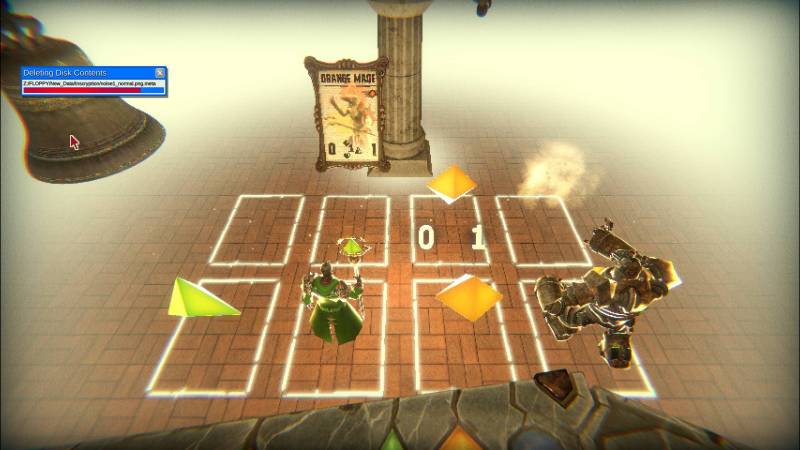
Seto Kaiba vibes
Eventually, the string runs out, and the game “deletes.” Your journey with Inscryption comes to an end. However, keep in mind this game can be bought online, so maybe P03’s plan worked after all… Joking, joking…or am I?
Overworld Narrative: Some Knob Named Luke
So throughout the game, real-life video with an actual actor is used to describe the overarching backstory of Inscryption.
In a nutshell, a trading card game influencer named Luke Carder (The Lucky Carder) has discovered an old game called Inscryption that was mysteriously discontinued after a fire occurred at the manufacturer and killed an employee. Following a set of coordinates scribbled on a physical card, he discovers a floppy disk drive that contains the original game.
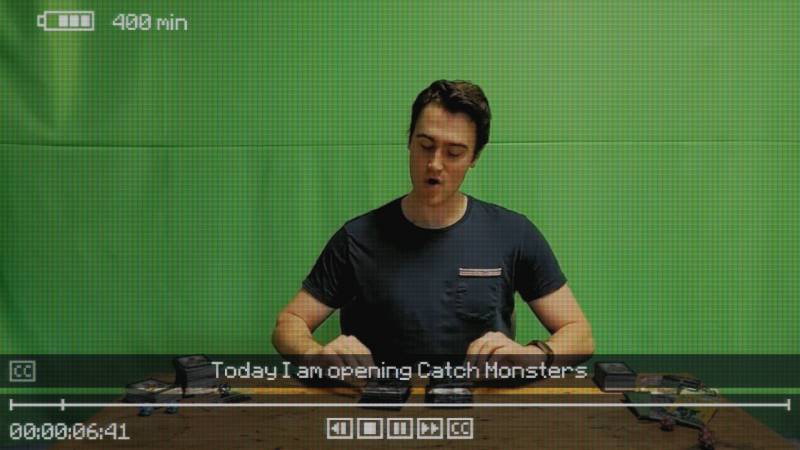
Upon booting up the game, more kooky shit starts popping off, like the original manufacturer expressing ignorance that a digital game exists and that he should return it if he doesn’t want legal action. A strange woman also shows up at his house to question his involvement in Inscryption.
It is revealed that you are actually Luke; the entire process of playing Inscryption has been Luke in the “real world,” discovering the secrets and unraveling the warped code of the game. Think of it like Jumanji.
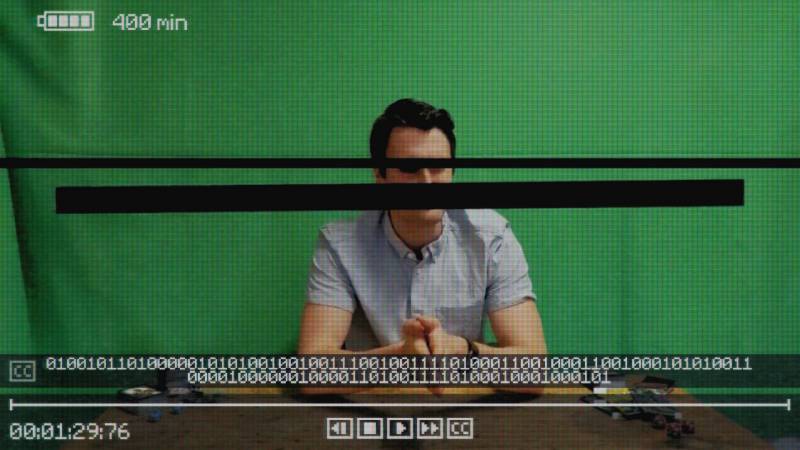
This story didn’t add much for me, but it’s not essential. You can totally skip it all, and your game experience will be pretty much the same. However, if you are that into the lore, by all means, give it a whirl and watch Luke slowly lose his mind.
There’s obviously something occult going on in the programming of Inscyption, with characters coming to life and having their own agenda, but that’s for you, the player, to find out. I really hope they don’t make a movie adaptation of this, but you never know with Hollywood; they’ve made 30 Fast and Furious movies, after all.
Inscryption Post-Game: Kaycee’s Mod (Spoiler)
Now we’re back to the fun. This is basically a return to Act I but with a twist! Embracing the rogue-lite aesthetic even more so, you can play against Leshy as if nothing had ever changed.
The key difference is that you can invoke different modifiers every time you beat him to increase the challenge level. Examples of such modifiers are preventing you from rerolling card rewards or making the rewards from killing minibosses like the Angler only common and uncommon as opposed to rare.
This is where the game is at its strongest, and I’m glad that they made a return.
The same rules apply as in Act I, where when you lose, you have to start again from the beginning with a fresh set of cards.
A notable difference is that you will always start with two pelts in their starter deck, and these can be traded at the first node on the map for one card apiece from a random assortment of 8.
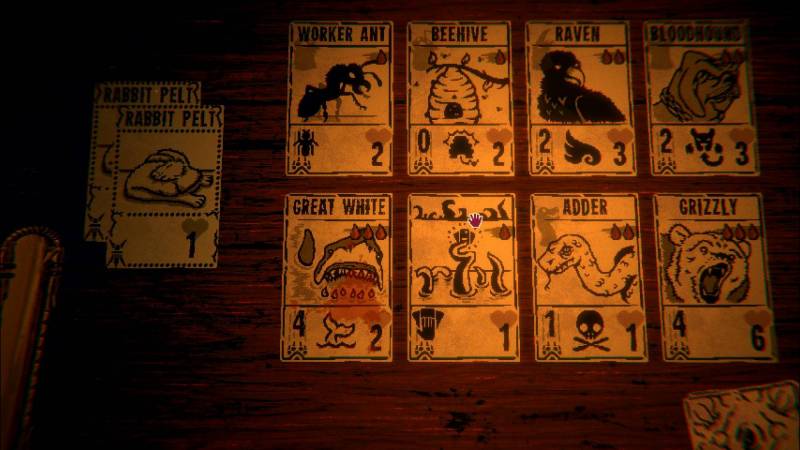
This allows you to customize your deck based on what you think may be useful.
As you demolish Leshy with additional challenges activated, you unlock extra modifiers but also additional starter deck options. These are combinations of three cards that follow a certain theme, such as one that relies on insects or another that focuses on aquatic creatures.
In any case, you can learn quite a bit from experimenting around during this stage of the game, as I have. Leshy isn’t fair, to begin with, but these modifiers can be especially brutal, so it’s really up to the player to break the game as much as possible in their favor.
For example, fireplaces scattered around the map are something that can be taken advantage of.
Normally, they will help you upgrade a stat of one of your cards (either attack or health). The first time is free, but a second upgrade comes with a chance that the villagers surrounding the campfire will eat your creature.
However, if you feed them a special card that is poisonous, let’s say, a ringworm (which is normally useless), they’ll die, and your next campfire will be free to use!
Another unassuming strategy is to take advantage of a “Geck.” This is a card that, while starting off with a singular point in attack and health, is completely free to play. In the beginning, it’s a Squirrel with a pellet gun, but should you choose to invest in its abilities and sigils, they become a powerful card that can be played at the drop of a hat for zero cost.
The point is there are many roads to victory, but you’ll have to be shrewd and observant.

Always look ahead and plan your route. Think, “What is my deck strong at, and what do I need to achieve it?”
After beating Level 12, you will not only have to play with a shitload of challenges activated, but you can also select a modifier to make the boss at the end (normally Leshy, but instead it’s some new guy) even harder. I will not spoil this, but it is a true fight for your life.
The rest, I’ll leave for you to discover because that’s the beauty of Inscryption. No two runs are the same; sometimes you’re f*cked from the jump, and sometimes you stumble on a god-tier combination that carries you through.
Should You Buy Inscryption?
I had a great time playing Inscryption, first and foremost. While the middle Acts were not as interesting to me, I can see where they were going with it from a narrative point of view. For 20 bucks, even if you only play for the beginning and the end, I think there’s a good deal here. You can easily blaze through the middle portion and get back to the good stuff for the price of a Chipotle dinner.
However, if you also find Acts II and II enjoyable as a brief intermission, then this is a slam dunk.
The endless variety within a confined structure is definitely something that appeals to me, and Inscryption handles it masterfully. I am going to give this game a 4.5/5, but it’s very likely that some of you will rate this higher. And that’s totally fine! The game’s simplicity belies its complexity and is another amazing addition to the landscape not created by a big studio. I applaud what they’ve done.
If you like card battlers, rogue gameplay, and/or have no plans (because I bet this game will suck you in), give Inscryption a whirl.
Inscryption sells for $19.99; it is available from Steam, Humble Bundle, gog.com, Epic, PlayStation Store, Xbox, Nintendo (Switch)
Developer: Daniel Mullins Games
Producer: Devolver Digital
Source: Personal Purchase
What I Like: Exceptional yet easy-to-understand card game mechanics, primarily in Act 1 and Post Game; A+ atmosphere and storytelling; Endgame that allows you to keep playing the best part…with a twist
What Needs Improvement: I didn’t care for Act II and III as much — they weren’t bad — Just a shadow of what Act I and Post Game are

Be the first to comment on "Inscryption Review: Your Creepy Uncle Invites You to Play Cards in an Escape Room …"